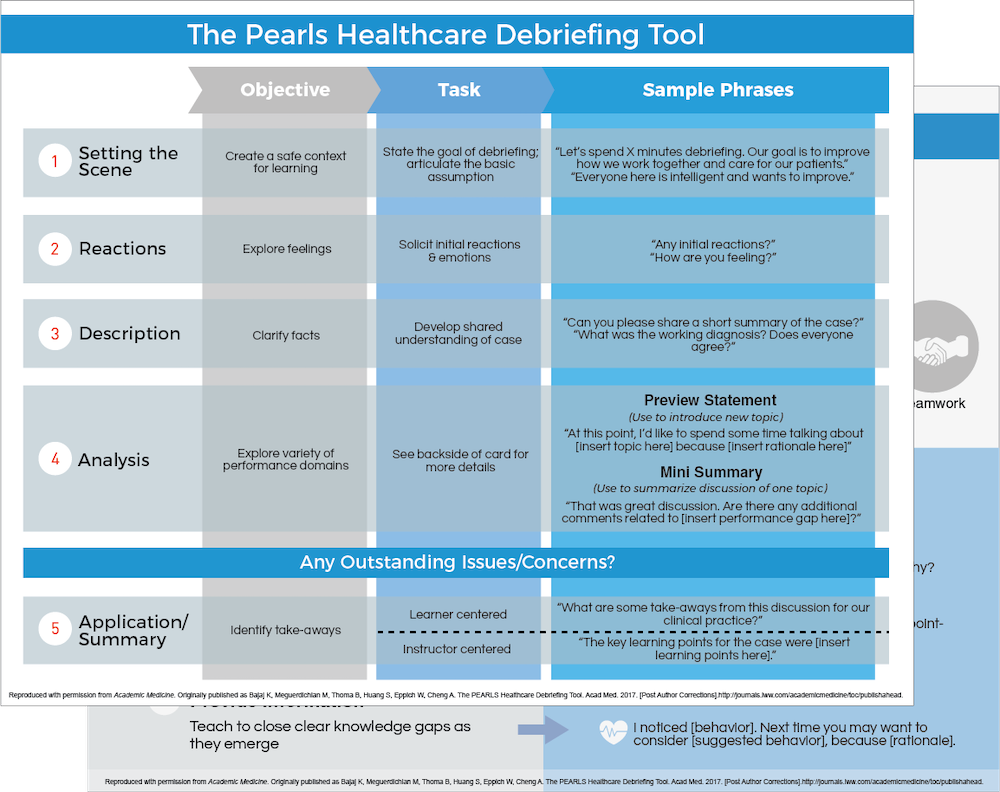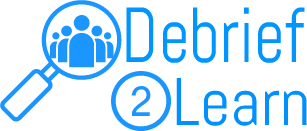PEARLS Debriefing Framework with Debrief2Learn Tool
Many educators consider debriefing as the most important step in healthcare simulation. Healthysimulation.com has previously published several guides to debriefing including the GAS method and Debriefing with Good Judgement. In 2015, Dr. Walter Eppich and Dr. Adam Cheng published a blended approach to debriefing entitled Promoting Excellence and Reflective Learning in Simulation (PEARLS) (Sim Healthcare, 10, pp 106-115), which Dr. Kim Baily PhD, MSN, RN, CNE shares about today, with key online links to tools below!
PEARLS Debriefing Framework with Debriefing Tool
Many educators consider debriefing as the most important step in healthcare simulation. Healthysimulation.com has previously published several guides to debriefing including the GAS method and Debriefing with Good Judgement. In 2015, Eppich and Cheng published a blended approach to debriefing entitled Promoting Excellence and Reflective Learning in Simulation (PEARLS). The authors created a framework using existing educational strategies for use in a variety of settings. Instructors can choose from three different methods of debriefing strategies depending on information received during the descriptive phase of debriefing and the time available for debriefing. This blended method allows instructors to tailor the discussion to the learner needs and learning context. In addition, this flexible method lends itself to a variety of educational goals including improving clinical decision making, improving technical skills, teamwork functions or interprofessional collaboration.
Sponsored Content:
Scripted Debriefing
Simulation is known to be most effective when it occurs in a supportive learning environment however, instructors may be reluctant to point out performance gaps because of fear of intimidating the learners. This is particularly true of instructors new to debriefing. Eppich and Cheng’s research found that instructors found scripted debriefings helpful however, when scripts were based on a single strategy, the scripts would work for some faculty but not all. Based on this research, Eppich and Cheng added specific scripts to their PEARLS framework to assist instructors to identify a debriefing method that best suited a particular group of learners or debriefing situation.
PEARLS Framework
- Setting the Scene – identify the clinical situation and summarize the debriefing process. Create a safe learning environment.
- Reaction Phase:
- Initial participation reaction/feelings.
- Ask the participants how they are feeling.
- Ask other learners about their reactions.
- Initial participation reaction/feelings.
- Description – provide information and clarify facts. This phase ensures that everyone is on the same page.
- E.g. What was the case and what interventions were made? “What happened”. Instructors should determine if the rationale for a performance gap is clear e.g. equipment used the wrong way or a statement that the learner did not know what to do next.
- Analysis – Identification of performance domains and performance gaps. Information from the description of the case is used to determine the debriefing method. Select a method which matches the learner level, time available and cognitive domain i.e. knowledge, technical or behavioral domain:
- Learner self-assessment (plus/delta). The learner generates objectives. (Ask learners to identify interventions that went well and would the learners want to change and why). This method is useful if time is limited or the participants did not share their reactions during the reaction phase.
- Focused Facilitation e.g. pros/cons, self-guided team corrections or advocacy-inquiry. This method is used when the underlying rationale for a particular action is not understood by the instructor and there is time to explore more deeply into key aspects of performance.
- Directed feedback – provides knowledge/information to eliminate performance gaps. This works for shorter time frames and for technical/cognitive content gaps.
- Summary: Application/Summary of lessons learned e.g. ask learners to identify two take-aways that can be used in the future (learner centered) or let instructor summarize key points (instructor centered).
Author note: Learners often have difficulty identifying exactly what they will do differently in the future. If possible, do not rush this part of the debriefing, give learners time to think. If a learner says “I will communicate better”, ask them to be specific and give an example of how they would change their communication in a particular individual or team setting. If they say “I will check labs, cardiac rhythm or vital signs before an intervention”, ask them to state what specifically what they are looking for and why.
Sponsored Content:
Eppich and Cheng’s article provides a helpful support matrix to assist faculty in matching debriefing method to performance domain.
Debriefing encourages learners to reflect on the events that occurred in a given simulation scenario to determine knowledge gaps and to identify old and new frames of reference to improve future clinical performance. Learners are much more likely to self identify performance gaps in an immersive learning situation versus a passive learning environment where the instructor points out mistakes. Eppich and Cheng’s framework provides a blended guide for new and experienced instructors to select the most appropriate debriefing method for their learners. Please see the link below for a printable debriefing tool.
. The authors created a framework using existing educational strategies for use in a variety of settings. Instructors can choose from three different methods of debriefing strategies depending on information received during the descriptive phase of debriefing and the time available for debriefing. This blended method allows instructors to tailor the discussion to the learner needs and learning context. In addition, this flexible method lends itself to a variety of educational goals including improving clinical decision making, improving technical skills, teamwork functions or interprofessional collaboration.
Scripted Debriefing
Simulation is known to be most effective when it occurs in a supportive learning environment however, instructors may be reluctant to point out performance gaps because of fear of intimidating the learners. This is particularly true of instructors new to debriefing. Eppich and Cheng’s research found that instructors found scripted debriefings helpful however, when scripts were based on a single strategy, the scripts would work for some faculty but not all. Based on this research, Eppich and Cheng added specific scripts to their PEARLS framework to assist instructors to identify a debriefing method that best suited a particular group of learners or debriefing situation.
PEARLS Framework
- Setting the Scene – identify the clinical situation and summarize the debriefing process. Create a safe learning environment.
- Reaction Phase:
- Initial participation reaction/feelings.
- Ask the participants how they are feeling.
- Ask other learners about their reactions.
- Initial participation reaction/feelings.
- Description – provide information and clarify facts. This phase ensures that everyone is on the same page.
- E.g. What was the case and what interventions were made? “What happened”. Instructors should determine if the rationale for a performance gap is clear e.g. equipment used the wrong way or a statement that the learner did not know what to do next.
- Analysis – Identification of performance domains and performance gaps. Information from the description of the case is used to determine the debriefing method. Select a method which matches the learner level, time available and cognitive domain i.e. knowledge, technical or behavioral domain:
- Learner self-assessment (plus/delta). The learner generates objectives. (Ask learners to identify interventions that went well and would the learners want to change and why). This method is useful if time is limited or the participants did not share their reactions during the reaction phase.
- Focused Facilitation e.g. pros/cons, self-guided team corrections or advocacy-inquiry. This method is used when the underlying rationale for a particular action is not understood by the instructor and there is time to explore more deeply into key aspects of performance.
- Directed feedback – provides knowledge/information to eliminate performance gaps. This works for shorter time frames and for technical/cognitive content gaps.
- Summary: Application/Summary of lessons learned e.g. ask learners to identify two take-aways that can be used in the future (learner centered) or let instructor summarize key points (instructor centered).
Author note: Learners often have difficulty identifying exactly what they will do differently in the future. If possible, do not rush this part of the debriefing, give learners time to think. If a learner says “I will communicate better”, ask them to be specific and give an example of how they would change their communication in a particular individual or team setting. If they say “I will check labs, cardiac rhythm or vital signs before an intervention”, ask them to state what specifically what they are looking for and why.
Eppich and Cheng’s article provides a helpful support matrix to assist faculty in matching debriefing method to performance domain.
Debriefing encourages learners to reflect on the events that occurred in a given simulation scenario to determine knowledge gaps and to identify old and new frames of reference to improve future clinical performance. Learners are much more likely to self identify performance gaps in an immersive learning situation versus a passive learning environment where the instructor points out mistakes. Eppich and Cheng’s framework provides a blended guide for new and experienced instructors to select the most appropriate debriefing method for their learners. Please see the link for a printable debriefing tool.
About Debrief2Learn
Debrief2Learn aims to improve healthcare outcomes by fostering effective feedback and debriefing practices. Effective feedback and debriefing play a critical role in healthcare education in both simulated and workplace-based environments. Debrief2Learn supports clinical educators by sharing resources to guide faculty development and exploring the latest innovations. They aim to create an online community of practice for health professions educators while advancing knowledge through cutting-edge collaborative research.
Learn More About PEARLS and Get The Debrief2Learn Tool Here!
Today’s article was guest authored by Kim Baily PhD, MSN, RN, CNE, previous Simulation Coordinator for Los Angeles Harbor College and Director of Nursing for El Camino College. Over the past 16 years Kim has developed and implemented several college simulation programs and previously chaired the Southern California Simulation Collaborative.
Have a story to share with the global healthcare simulation community? Submit your simulation news and resources here!
Dr. Kim Baily, MSN, PhD, RN, CNE has had a passion for healthcare simulation since she pulled her first sim man out of the closet and into the light in 2002. She has been a full-time educator and director of nursing and was responsible for building and implementing two nursing simulation programs at El Camino College and Pasadena City College in Southern California. Dr. Baily is a member of both INACSL and SSH. She serves as a consultant for emerging clinical simulation programs and has previously chaired Southern California Simulation Collaborative, which supports healthcare professionals working in healthcare simulation in both hospitals and academic institutions throughout Southern California. Dr. Baily has taught a variety of nursing and medical simulation-related courses in a variety of forums, such as on-site simulation in healthcare debriefing workshops and online courses. Since retiring from full time teaching, she has written over 100 healthcare simulation educational articles for HealthySimulation.com while traveling around the country via her RV out of California.
Sponsored Content:




















